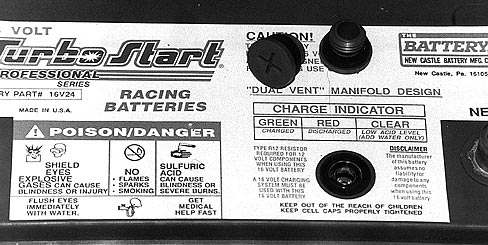|
16 Volt Race Car
Batteries
by Wayne Scraba
photos by Wayne Scraba
9/15/03
 our
racecar doesn't run on petrochemicals. It runs
on electricity. Ignition systems need battery
power to operate. But what type of battery is
required? Batteries are rated by capacity. This
is the amount of electrical current or amps
a battery can supply for a specific amount of
time. Older battery ratings revolved around
"Ampere Hour" ratings, but the newest rating
system is the "CCA" or Cold Cranking Amps system.
The CCA determines the battery's capability
of delivering current (amps) under cold conditions.
This rating will generally range from 250 to
800 amps, but keep in mind that many (if not
all) CCA ratings are rather optimistic. To combat
the factory rating game, compare the "RC" or
Reserve Capacity ratings of the batteries in
question. This rating determines how long the
ignition and other electrical components can
be operated by the battery alone (without the
generator functioning). The RC rating is defined
as the length of time (minutes) that a fully
charged battery can deliver 25 amps of power
at eighty degrees F (maintaining 10.5 volts).
In other words, the higher the RC, the better
the battery. our
racecar doesn't run on petrochemicals. It runs
on electricity. Ignition systems need battery
power to operate. But what type of battery is
required? Batteries are rated by capacity. This
is the amount of electrical current or amps
a battery can supply for a specific amount of
time. Older battery ratings revolved around
"Ampere Hour" ratings, but the newest rating
system is the "CCA" or Cold Cranking Amps system.
The CCA determines the battery's capability
of delivering current (amps) under cold conditions.
This rating will generally range from 250 to
800 amps, but keep in mind that many (if not
all) CCA ratings are rather optimistic. To combat
the factory rating game, compare the "RC" or
Reserve Capacity ratings of the batteries in
question. This rating determines how long the
ignition and other electrical components can
be operated by the battery alone (without the
generator functioning). The RC rating is defined
as the length of time (minutes) that a fully
charged battery can deliver 25 amps of power
at eighty degrees F (maintaining 10.5 volts).
In other words, the higher the RC, the better
the battery.

When you receive a battery from TurboStart,
it's usually dry- charged. That means you have
to add your own dry charge sulfuric acid. 4.2
quarts of battery grade sulfuric acid is required
to activate the battery. Then the battery is
activated, one of the red rubber vent plugs
must be removed for venting purposes (more in
the next photo). During "activation", remove
the slotted cell plugs from each cell and fill
with acid to 1/4" over the top of the plates.
When all of the cells have been filled to this
level, let the battery sit for at least two
hours to allow the electrolyte to be absorbed
by the plates and separators. Be sure to adjust
the acid level to no more than 1/4" above the
plates.
RC To Ampere Hours
Thanks to MSD, there is a formula which can be used to easily convert the RC
rating into the "old" (you can read that as "useful") battery rating number --
ampere hours (Ah:
25 amps X Reserve Capacity (minutes) = AA 60
Using the above formula, if the battery reserve capacity is 30 minutes, the
ampere hour capacity is as follows:
25 amps X 30 = 12.5 Ah 60
The above figure simply means that the battery can supply 12.5 amps of power
for one hour. MSD advises that ignition operating time decreases as engine RPM
increases. The smallest dedicated battery for use on a MSD 6 or 7 series
ignition system is a 12 Ah package. Other ignition systems may require more.
There's no question that today's crop of race cars are becoming more electrically
sophisticated. Large capacity electric fuel
pumps, electric water pumps, electric fans,
electric (or "electronic" solenoid) shifters,
throttle stops and even small things like shift
lights deplete power and Ah from the battery.
Because of this, you have to first determine
how many amps (Ah) each of the electrical "accessory"
components continuously draw from the battery.
For example one of the large billet electric
fuel pumps can draw 8 Ah or more. Once you've
determined each component's Ah draw, add up
the total Ah figures. Using the following chart
from MSD, you can then determine the total Ah
draw of a typical high powered ignition system
at a specific engine RPM.

|